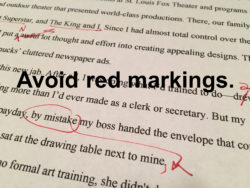
Many writers roll their eyes at the topic of “critique.” We’ve heard the clichés about making nice. However, most writers aim for excellence and occasionally relapse into old habits. I dedicate this blog piece to a dear critique mate whose oral commentary of my partial novel amounted to “I hate Prasanga.” No amount of training or reprimand honed his comments.
That partial manuscript still sits in a drawer. I write a page here and there. Did my critique mate squash my inspiration? Not really, but maybe. At that point I hated my main character too. I was tired of him. I’d already written one book about Prasanga as a boy in the underworld. Grow up Prasanga, I thought. Move on Kaye. Time for this writer to seek other venues. I smile when I remember that day. I recall exactly where I sat, who sat around the table, the horrified expressions in response to the comment that seared.
In honor of the writer who never reined in his words, here are tips on the skill, the art, the diplomacy of critique. In my usual brief, concise style, I keep it simple and to the point.
- Critique the work and not the writer. In other words, instead of “you used a boring title” consider “the author’s title is vague. Maybe she might consider a more specific one that relates more to the story?” Courtesy in most MFA classes requests that the readers state in their critiques something like “the author said…” instead of “you said…” It makes it less personal and does not feel so much like an attack on the person receiving the critique. It works well, but takes some practice. It is an entirely different approach than most of us are used to.
- Be honest but tactful. Obvious? You would think so but not necessarily in practice. “The story has so many colorful characters, but I got a little lost keeping track of who was doing what.”
- On the receiving end, never argue with someone about his or her critique. Every reader has a differing perspective. Accept what you like and leave the rest, but listen. Sometimes there’s a glimmer of gold in a comment you don’t want to hear. Hopefully, the people in your critique group offer their opinions with the intention of strengthening your writing.
- A strong critique “shows” and does not “tell.” Offer specific examples to support statements. “On page three, Jennifer’s eyes are blue but on page ten, her eyes are brown.” (Woops!)
- Offer three aspects of the writing that worked well before launching into those that don’t. “The desert acts like a character in your story. Its heat is overwhelming; it causes fear, creates conflict and yet those caves protect the main characters, almost in a loving way. That works so well.”
- Give suggestions for improvement or strengthening: “Even though the storyline was riveting, the ending seemed sudden. Could the main character find a resolution to the conflict rather than take a dive off that cliff?”
- In stories, suggest and listen for conflict, conflict, conflict, because life is about conflict and resolution. Point out where conflict was engaging and listen to whether the resolution worked.
- Forget “I loved” “I hated” “I didn’t like” “It was good.” “It was boring.” Specifics work well in writing, and concrete specific suggestions work well in critique. “I laughed when the clown danced with Jennifer in the circus tent. What a well-written scene. I could see it in my head.”
- If the critique is a written one, stay away from red markings (school m
 emories) and capital letters which can be misinterpreted as shouting.
emories) and capital letters which can be misinterpreted as shouting. - Print out the manuscript with double-spacing or room in the margins or under the lines for notes or comments. Keep the comments legible.
- Put a name on the written critique so the writer can identify the critique giver. The author should thank the giver of a critique at the end of the group session or in a follow-up email.
- If the work contains violence, profanity or is sexually explicit, the readers of the piece need to be given a warning. A phrase on the top of the manuscript does this. “Contains graphic violence.” Some readers might elect to opt out of the critique of such work. In my MFA class, I had a difficult time critiquing a classmate’s work because she was pro end-of-life euthanasia. I could not read her work and offer a fair critique of her manuscript. Instead of judging her perspective, I opted out of the critique. (I have since come to understand both sides of that argument.)
- Critique groups form their own rules. Adhere to the rules of engagement and visit groups before officially joining. Each group has its own personality and style.
- Unfortunately, there is something to be said about “developing a thick skin.” If one is overly sensitive to tactful suggestions, there is no room for catching that golden comment. It’s amazing how writing can take off and succeed after honing a manuscript with a group of readers.
- Remember how it feels to be a new writer. Never forget that feeling of vulnerability. Seasoned writers and critiquers are often more open to suggestion and a little tougher, but we never know whether there is a little girl or boy cringing within the writer’s heart when receiving a critique. Stay sensitive and tactful, but be honest. A writer improves by astute and well thought out suggestions.
 I am still writing today because I was a seasoned writer when my critique mate said he hated my book. If I had been a new writer, I might have gone fetal, missing, never to be heard of again.
I am still writing today because I was a seasoned writer when my critique mate said he hated my book. If I had been a new writer, I might have gone fetal, missing, never to be heard of again.
For more information on critique groups and the fine art of suggestion, check out various websites, and review the following books:
Amato, Carol J. How to Start and Run a Writers’ Critique Group.
Rogers, Bruce Holland. Word Work: Surviving and Thriving as a Writer.

Joan H. Carter
We pod members would do well to reread your fifteen tips periodically. Thank you!
Ann~Marie Magné
Hey, Kaye – I hadn’t read this until I followed the link from Joan’s blog post. Good stuff! “The writer” has made some excellent points.